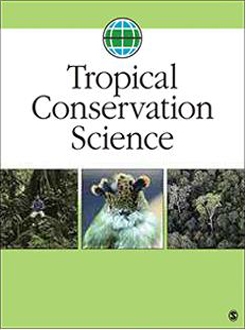Tropical Conservation Science, launched in March 2008, is an open access journal hosted by Mongabay.com, a leading web site that harbors and disseminates information on tropical forests and other tropical ecosystems. TCS publishes conservation-oriented research conducted by scientists and conservationists working in the tropics. A strong editorial board coupled with a peer-review process ensures TCS publishes high quality papers.
Tropical Conservation Science is a registered publication (ISSN 1940-0829) in the National Serials Data Program (Library of Congress, Washington, DC). TCS publishes four issues per year, as well as occasional special issues proposed by interested scientists and conservationists.
TCS is included in Thomson-Reuters' Biology & Environmental Sciences, JCR (Journal Citation Reports), SCIE (Science Citation Index Expanded), Current Contents / Agriculture. TCS is also in SCOPUS and in the Directory of Open Access Journals (DOAJ), CAB Abstracts, EBSCO Publishing Databases, Google Scholar, Open Access Net of Germany, and Urlich's Periodicals Directory.
The next three pages provide a quantitative synopsis of aspects reflecting the growth of TCS.
Manuscripts received between 2008 and 2014
The first issue published by TCS had five papers. During that first year, 58 manuscripts were submitted for consideration. Since then, TCS has substantially expanded. In 2014, 134 manuscripts were received (see graph below). Overall, between 2008 and 2014 TCS received 613 manuscripts for possible publication, 45 percent of which made it through the peer review process and were eventually published.
Trends in manuscripts published
Between 2008 and 2014, TCS published 30 issues (28 regular issues and 2 special issues), 266 papers, and a total of 4,010 pages. In addition, each issue was accompanied by an editorial (average length 2pp.). The graphs below show the steady increase in manuscripts published since 2008, a trend paralleled by the number of published pages.
Geography of published manuscripts
Manuscripts have been received from scientists in the Neotropics, Africa, Southeast Asia, South Asia, China, Russia, Eastern Europe, Central Europe, the United Kingdom, the United States, and Australia.
The geography of the manuscripts published by TCS encompasses most tropical regions, with a predominance of studies conducted in the Neotropics. However, when the Neotropics is compared to studies from the Paleotropics, the two major regions show a balanced distribution, 51% and 49%, respectively.
Trends over time in the geography of published manuscripts.
While there are important variations in the number of published manuscripts from the Neotropics and the Paleotropics since 2008, both regions display an overall positive growth trend.
TCS Impact factor
TCS impact factor in the Journal Citation Reports of Thomson Reuters has grown rapidly since TCS started to be monitored by this agency (see graph below). This suggests that TCS is becoming widely known as a high quality journal in the field of conservation science in the tropics.
Referees
The above developments would not have been possible without the assistance of the numerous colleagues in various parts of the World who volunteered their time to review and provide their editorial opinions on the manuscripts considered for possible publication, in many cases reviewing the same manuscript more than once.
Copy editors
Of utmost importance has also been the work of TCS copy editors for English. This task was carried out by Mr. William Bridges, Director (Ret.), Pulliam School of Journalism at Franklin College, until 2010. Later Ms. Carol Van Strum took over this task, also doing an outstanding job in helping authors, especially those who speak English as a second language.
First issue of TCS in 2015
The current issue of Tropical Conservation Science includes 19 articles. The first six are part of a special section on approaches to restoring lowland rain forests in Indonesia. The guest editor for the section is Dr. Rhett Harrison from the World Agroforestry Centre, East and Central Asian Regional Office, in Kunming, China. The rest of the papers include 11 Research Articles, one Opinion Article and one Short Communication. Six of the research articles are based on studies in the Neotropics. The other studies report on cocoa farming and extinction of primates in west Africa, on butterflies, bats and beetles as bioindicators in Malaysia, on monoculture forests in subtropical China, on invasive trees in Singapore, and on the genetic structure of Teak in Myanmar. The Opinion Article proposes the use of lianas in restoration of tropical rain forests. The Short Communication reports on land-use and land cover changes in an Important Bird Area in Driefontein Grassland, Zimbabwe. As a group, these 19 contributions to the first issue of TCS in 2015 provide a rich array of information on challenging conservation issues in varied geographic regions.










